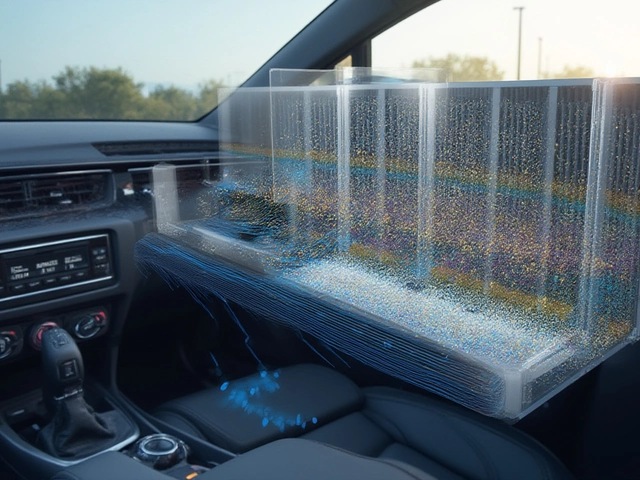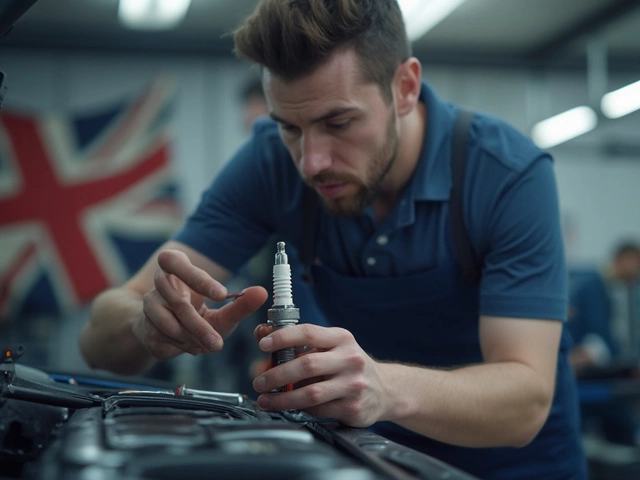You've probably heard mechanics say, 'Replace your rotors along with your brake pads.' But what if you're trying to save some cash and just swap the pads? Here's the straight-up answer—new brake pads on worn rotors can work, but it's far from a perfect match. Your braking won't be as smooth or as strong as it should be. Plus, you might end up back at the shop sooner than you think.
The pads and rotors actually wear into each other over time, kind of like how your favorite pair of shoes fit your feet just right. If you slap on fresh pads, but leave the old, grooved rotors, those new pads have to wear down fast just to fit the rotor's shape. You'll often notice your brakes squeal, vibrate, or stop less effectively—and no one wants that kind of surprise in heavy traffic. We'll dig deeper into what to watch for and what really happens if you don't do both at once.
- How Brake Pads and Rotors Work Together
- Signs Your Rotors Need Replacing
- What Actually Happens If You Change Pads Only
- Risks of Skipping Rotor Replacement
- When It’s OK to Reuse Rotors
- Tips for Keeping Your Brakes in Top Shape
How Brake Pads and Rotors Work Together
When you hit the brakes, it's not magic—it's all about friction. Your brake pads and rotors form a team every time you want to slow down. Here’s how it breaks down: the pads press up against both sides of the spinning rotor (that’s the metal disc you see behind your wheel), using friction to turn your car’s motion into heat, then safely to a stop. The better the contact between pads and rotors, the smoother and shorter your stopping distance.
Over time, both brake pads and rotors wear down, and they tend to do it together. The pad’s surface gets thinner, while the rotor ends up with grooves and little ridges from all that contact. It’s kind of like sandpaper shaping a block of wood. If either part is too worn or damaged, you lose braking performance—and that’s a safety issue.
- Brake pads are made from material that can handle crazy heat (sometimes up to 500°F during sudden stops), but they’re meant to wear out and get replaced.
- Rotors are tougher, usually made from cast iron or composite materials, but they’re not indestructible. Deep grooves, warping, or too much thinning means they can't do their job right.
If you’re wondering why both get attention during a brake job, here’s a quick look at how their relationship works day-to-day:
| Brake Pad Role | Rotor Role | What Happens |
|---|---|---|
| Presses against rotor | Spins with the wheel | Car slows or stops |
| Wears out first | Gets minor grooves | Surfaces adapt to each other |
| Needs full, even contact | Must be smooth and flat | Max braking power |
Miss-matched pads and rotors—like a new pair of sneakers on a slippery floor—just don’t connect well. That’s why shops always check both, even if you only came in for brake pads.
Signs Your Rotors Need Replacing
Let's get real—most drivers don’t check their rotors until something feels or sounds off. But ignoring your rotors can mess up your brake maintenance and leave you with bigger repair bills down the road. Here’s what you should look out for if you’re wondering about those rotors when replacing your brake pads:
- Vibrations when braking: If your brake pedal feels shaky or your steering wheel wobbles during stops, your rotors are probably warped or uneven. That’s a clear red flag.
- Grooves or deep scoring: Give your rotors a look through the wheel. Notice deep lines, gouges, or rough spots? That means the surface is chewed up and needs replacing.
- Unusual noises: Squealing, grinding, or scraping when braking usually signals the pad is hitting something rough or uneven—often the rotor’s fault.
- Longer stopping distances: Taking longer to come to a stop? Your old rotors might be too thin or too warped to grip the brake pads efficiently.
- Blue coloration: If the rotor looks bluish in spots, it’s overheated. This happens from hard, repeated braking and leads to poor performance.
- Warning dash lights: Some modern cars literally tell you when there's a brake problem—including issues with the rotors themselves.
| Rotor Thickness (Minimum) | Common Vehicle Range |
|---|---|
| Disc Front Rotor | 22mm - 28mm |
| Disc Rear Rotor | 10mm - 20mm |
It’s smart to measure your rotor thickness. Most rotors have a "minimum thickness" stamped on the edge. If they’re below this mark, swap them out. A 2023 report from Consumer Reports even says,
"Driving on worn or warped rotors turns everyday stops into unpredictable events, raising your risk of accidents—even with new brake pads."
So if you spot any of these red flags, or your rotors are thinner than your car’s manual suggests, don’t put off replacing them. Skipping this step in brake repair almost always costs you more in the long run.
What Actually Happens If You Change Pads Only
If you're only swapping out the brake pads and skipping the rotors, a few things happen right away. First, those new pads are trying to grab onto an old, possibly uneven surface. Rotors get grooves, ridges, and even a glaze from all the heat. When pads and rotors aren't matching up, your stopping power goes down.
You'll probably feel the brakes pulsing or hear squeaking. That's the new pads wearing unevenly as they try to fit the old rotors. In some cases, braking distance goes up—meaning you need more room to stop. That's risky stuff if you're driving in busy city traffic or coming off the freeway ramp.
Uneven or worn rotors can even cook your fresh brake pads faster. You might think you're saving money upfront, but you’ll burn through those new pads quicker than normal. Sometimes, the pads glaze over, turning hard and shiny, which kills your brakes’ grip even more. If you've ever pressed on your brake pedal and felt a vibration, that's often because new pads are seating against warped or rough rotors.
Here's a quick look at what car techs and drivers typically notice after pads-only changes:
- More noise – squeaks and grinding sounds
- Shaky or jumpy brake pedal
- Longer stopping distances
- New pads wear out way faster than normal
- Sometimes, pads can crack or glaze
According to repair shop estimates, drivers who replace just the brake pads often come back needing a full brake job within 10,000-15,000 miles—way under the usual 30,000-40,000 for a fresh set of pads and rotors. That means any money you saved gets eaten up by getting the job done twice.
So, it’s not just about squeaks. Your safety, your car’s performance, and your bank account all take a hit if you skip the rotors when they’re actually worn out.

Risks of Skipping Rotor Replacement
So what can actually go wrong if you install fresh brake pads but leave the old rotors? It’s not just about annoying noises—it can mess with how safe your car actually is.
The first big issue is uneven wear. Old rotors are usually grooved or even slightly warped. Put new pads on them, and those pads have to quickly grind down to match all those bumps and dips. That creates extra dust, more heat, and usually a nasty squealing or grinding sound right after the job.
- Reduced stopping power: Your brake pads won’t be making full contact with the rotors, so it takes longer to stop—sometimes several car lengths more, which is a big deal in an emergency.
- Vibration or pulsing: Warped rotors can make your whole steering wheel shake when you hit the brakes. This isn’t just annoying—it can throw you off, especially on wet or rough roads.
- Shorter pad life: Because the new pads have to eat into the old rotor grooves, they wear down faster. That means you’re back to paying for another set of brake pads way sooner than you'd like.
- Overheating risk: When rotors have deep grooves or hot spots, they can’t cool off as well as smooth ones. This can cause brake fade (where you press the pedal and nothing happens for a moment), which is honestly pretty scary, and increases the risk of warping the rotors even more.
Just to put some numbers in there, a test by a national auto service chain showed that cars with badly worn rotors and brand new pads needed up to 20% more distance to come to a full stop compared to those with fresh rotors. That can be the difference between a safe stop and a fender-bender.
Even if the upfront savings look tempting, skipping rotor replacement can wind up costing you more—both in money and peace of mind. If you’re already spending the time and cash to handle your brake pads, it just makes sense to check if your rotors are ready for a swap, too.
When It’s OK to Reuse Rotors
Not every brake job needs a brand-new set of rotors. Sometimes, keeping your current rotors makes sense—and it can save you money if you do it right. But it’s not just about guessing. Your rotors need to tick a few specific boxes before you can skip a replacement.
First, make sure your rotors aren’t too thin. There’s an exact minimum thickness printed right on the edge of most rotors or found in your car’s manual. Anything less and your rotors are toast. If you go under that minimum, the metal can't handle the heat from braking, and you’re risking real trouble.
Next, check for grooves or deep cuts. You want your brake pads to hit a pretty smooth surface. A little surface rust isn’t a problem, but if your fingernail catches in a groove or the rotor looks like an old vinyl record, it’s better to swap them out. Warped rotors are another deal-breaker. If your steering wheel shakes when you brake, that’s usually the rotors telling you they’re done.
So when is it really OK to keep the old rotors? Here’s a checklist that covers the must-haves:
- Rotor thickness is still above the minimum spec (use a micrometer to check)
- No deep scoring, grooving, or big heat spots
- No warping or major rusting
- Surface is even—if in doubt, have them resurfaced (or "turned") at a shop
According to a 2023 AAA Car Care survey, about 40% of drivers who replaced just their brake pads could safely reuse their rotors—because they checked these boxes. But those who ignored this stuff ended up with noisy brakes or trouble stopping only a few months later.
Quick tip: If your rotors are still good, have a mechanic measure and clean them up. And always bed in your new pads properly, so they match up to the rotor’s surface right from the start.
| Rotor Condition | Replace Needed? |
|---|---|
| Above minimum thickness, surface OK | No, can reuse |
| Thin, warped, or deep grooves | Yes, replace |
| Minor surface rust | No, can reuse if cleaned |
If you stick to these facts, you can safely reuse rotors and make your brake maintenance dollars go a lot further.
Tips for Keeping Your Brakes in Top Shape
Taking care of your brake pads and rotors doesn’t have to be complicated, but skipping on regular checks can cost you way more in the long run. The best way to keep your car safety game strong is to be proactive. Don’t just wait for squeaks or shakes—little habits make all the difference.
- Check your brakes every 10,000 miles. During tire rotations or oil changes, just ask your mechanic for a quick brake check. Catching a worn pad or grooved rotor early keeps damage from spreading.
- Keep an ear out for odd noises. Squealing, grinding, or clicking isn’t just annoying—it’s your car telling you your brake repair is overdue.
- Don’t ignore the brake warning light. Modern cars have sensors for a reason. If the light pops on, get things checked right away before small problems turn big.
- Use the right parts for your car. Putting on super-cheap brake pads or mismatched rotors might save a few bucks, but they usually wear out faster or damage the rest of your system.
- Flush your brake fluid every 2-3 years. Old, dirty fluid can mess up braking performance and shorten the life of your brakes.
- Go easy on the brakes when possible. Sudden hard stops wear out your pads and rotors fast. Try to coast or brake gently, especially downhill or in stop-and-go traffic.
If you’re kind of a numbers person, check this out:
| Brake Component | Average Lifespan (Miles) | Replacement Cost (per axle) |
|---|---|---|
| Brake Pads | 30,000 - 70,000 | $100 - $300 |
| Rotors | 50,000 - 70,000 | $200 - $400 |
Staying on top of your brake maintenance isn’t just about saving money—it's about keeping everyone safe. Little steps now mean fewer surprises and better stops when it matters.




